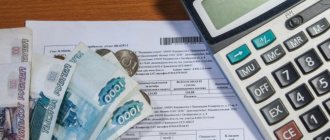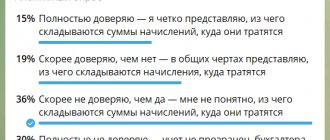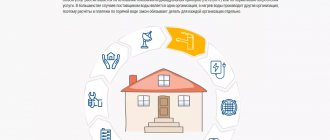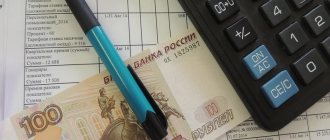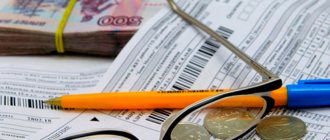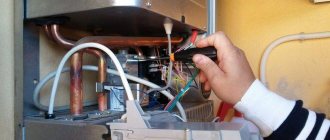Several times I had to conflict with employees of the management company due to incorrect charges for sewerage. For some reason, I ended up paying more than the charges for the water consumed. I thought that I didn’t really understand the meaning of the term, so I first decided to figure out what sewerage is in a housing and communal services receipt.
It turned out that in fact we are talking about ensuring the recycling of used water. Each utility bill indicates the volume of water drained into the sewer and a fee is charged for this. In my article I will talk in detail about why it is necessary to pay for sewerage and what consequences refusal to pay may have.
Law
The main regulatory document regarding water supply and sanitation of houses is Federal Law dated December 7, 2011 N 416-FZ. It regulates the procedure for providing services to the population and organizations by relevant companies.
This law regulates the following principles and objectives within the framework of water supply and disposal:
- powers of government authorities at all levels in this matter;
- the procedure for supplying hot and cold water and its disposal;
- ensuring and monitoring the quality of supplied water;
- principles of environmental conservation in this field of activity;
- regulation of the application of tariffs.
The procedure that public utilities follow when providing services to the population is prescribed in the Rules approved by Decree of the Government of the Russian Federation No. 354 of 05/06/2011. It also defines services for the supply and disposal of water to apartment buildings and private buildings.
Is payment important?
Payment for water drainage services is not just an empty ploy to rake in even more money from the taxpayer; this type of payment was established within the framework of the legal and regulatory acts of the Russian Federation, namely [1] Federal Law No. 416, Article 16. We pay bills for civilized disposal drains so that used sewage water is not drained onto the streets, but is taken to special processing and recycling plants.
If you are in doubt about the need to pay for sewerage, you can contact the water management company in your apartment building and request detailed information, which must be provided in writing. To be more informative, when submitting an application, request the maximum possible list of documents describing the services.
Drainage - what is it on the receipt?
Nowadays, many people monitor their utility bills and navigate calculations and concepts. Let us clarify what the lines in the receipts mean that are associated with such an important resource for us as water. Its consumption by each of us is divided into two concepts:
- Water supply . This is the water that is supplied by the utility supplier to the systems of an apartment building; it runs from our taps. According to the regulatory document, a round-the-clock uninterrupted supply of both cold and hot water of proper quality must be ensured. This means that purified water that meets the standards must flow from the taps in the living area. The temperature of the hot water supply is also established by the standards and must be supplied no lower than their values (water heating is highlighted on the receipt as a separate line).
- Water disposal . The received water is used and then transported through the sewerage system. The law gives the concept of this process, which includes the reception of wastewater, transmission through centralized sewerage systems to treatment facilities and their subsequent treatment (clause 2 of article 2 of Law No. 416-FZ).
What does a receipt for payment for heating housing and communal services look like: decoding of bills in the notice
It is compiled according to the same principles as a receipt for other types of resources. Sometimes it is simply included as a line in the general payment document.
The gas bill may arrive separately, with a large logo of the organization. There are details, a unique code for quick payment through the scanner, and the accrued amount.
What is ICU in housing and communal services, how does it differ from housing and communal services
This refers to the provider of services: the supplying, management company. Housing and communal services are what you can use at home: electricity, water, and other benefits. Therefore, ICU and housing and communal services are different indicators.
Who generates payments?
Some of them are created and sent to homeowners by the management company. Usually they calculate the debts of the population for:
- water supply;
- major repairs;
- apartment.
In some regions, management companies send receipts for gas and electricity supply, but more often this is done directly by the suppliers themselves.
Are drainage and sewerage the same thing?
Not everyone knows that drainage and sewerage are different concepts! Those homeowners who do not pay for sewerage are acting illegally, believing that it is the same thing. Let's find out if this is true.
What does drainage consist of?
Disposal of water used for the needs of apartment buildings and private buildings is an important event, consisting of:
- drainage of domestic wastewater from residential and non-residential premises through centralized sewer networks, which must be carried out around the clock;
- transportation of wastewater to treatment facilities;
- passing through a cleaning and disinfection system with subsequent use for technical purposes or discharge into natural bodies of water.
Conclusion: All sewage is removed from the house by drainage, then it is cleaned, and only then collected in the sewer and transported. In order for all systems to work efficiently and uninterruptedly, it is necessary to constantly maintain them in normal working condition. And this requires certain financial costs, which are covered by resource consumers.
Is it possible not to pay for sewerage?
Some citizens believe that sewerage is not a mandatory column in the payment receipt, so there is no need to pay for it. As a result, the user accumulates debt.
Of course, it is simply necessary to pay the payment receipt.
Otherwise, the Criminal Code will force the user to pay a fine. They cannot disconnect the client from the sewerage system.
In this case, the management company may:
- Charge the user a late fee. They are awarded in 10th month. Therefore, if the client did not pay for the services in December, then in January he will receive a receipt with the debt and penalties. Remember: the more the client does not pay for the service, the more his debt and penalties grow.
- Force customs officers not to allow the debtor to go abroad. Remember: currently, persons who do not pay utility bills, traffic police fines, and alimony are not allowed to travel abroad. Therefore, a traveler should check in advance whether he has debts or not.
How is it paid?
Many apartment buildings are serviced by management companies that enter into agreements with water supply and sanitation service providers. Therefore, they calculate the fee for each specific apartment and display the amount on the receipt. Owners of private houses independently enter into contracts with the resource supply organization if the house is connected to centralized water supply and sewerage networks.
Service fees are charged by the management company on a monthly basis. It depends on the amount of water consumed according to the meter or, in the absence of a meter, according to the standard. For the calculation, the volume of cold and hot water is taken. The same number of cubic meters should go into the sewer.
Good to know: How to apply for and calculate a subsidy for housing and communal services?
Calculation examples
In many apartments and private houses, meters for metering consumed resources are already installed. Therefore, the starting point for calculating the consumed water that must be disposed of is the water meter readings.
WATER DISPOSAL = (DHW + cold water) × TARIFF
Since the payment for hot water supply consists of the consumed volume of cold water and its heating, in receipts you can see lines such as:
- cold water supply - the number of cubic meters of cold water according to the meter;
- water heating - only that volume of hot water supply (m3) that is taken from the meter reading (IPU).
Example. At the end of the month, readings were taken from water meters in the apartment of citizen M:
- cold water - 10 cubic meters;
- DHW - 3 cubic meters.
In total, 13 cubic meters of water were consumed, which had to be diverted.
The tariff for these purposes is set at 25 rubles in the receipt: (10 + 3) × 25 = 325 rubles.
You should pay attention to the coincidence of the consumed and allocated volume. If a difference is noticed, you need to contact the management company for clarification as to why this happened.
Ways to reduce the payment amount
The fee for such a service can be high. This happens if 3-4 people are registered in the real estate, but only one person lives in it, who does not have metering devices.
Remember: if the real estate does not have meters, and the person is often not at home, then you will have to pay a large sum of money for this service.
Moreover, even if no one lives in the property, they will have to pay for water drainage. It is best to install a meter and pay for utilities using it.
Installing the devices is quite simple.
The user only needs:
- Visit the HOA, housing and communal services, management company, tell about your intention to purchase a water meter. The client must take a passport and property documents. At the office, he must receive a document, fill it out, double-check the information, sign it, and decipher it.
- Buy a water meter. Moreover, you need to purchase not only meters, but also all materials for installation. Remember: you will have to purchase 2 meters. You can also install a meter at each point of consumption. This way the readings will be more accurate. Remember: the shorter the device is in the store, the more accurate information it will show.
- Install water meters. They can be installed independently or through an employee of a company dealing with this issue. Moreover, he must not only install the water meter, but also seal it and check its functionality. After installing it, the user must receive documents that in the future must be submitted to the Criminal Code.
Remember: if the user installs a water meter on his own, he will still need to send documents to the management company, water utility or other companies that will help seal it.
- Request recalculation. The user must notify the management company about the installation of a water meter. Next, he needs to fill out the appropriate form. The recalculated amount is small, but the client will save in the future.
Now he only needs to transfer readings from water meters to the service provider or to the management company every month.
Water disposal at ODN in 2021
Residents of apartment buildings are also required to pay for such expenses as general house needs. If a collective metering device for water disposal is installed in the house, then it is easy to measure the difference by its readings and the drainage of water from apartments supplied by individual metering devices.
If such a deviation is present, then this will be one. Needs are distributed to each apartment in proportion to its area in the total volume of premises of the house.
If a device that specifically takes into account water drainage is not installed in an apartment building, then residents are not required to pay for the ODN for this item. This is due to the fact that standards are not established here, and therefore there is no calculation procedure.
Abbreviations that appear in the document
First, let's find out what these abbreviations are in the receipt - ELD, ASPP, EE, RC services, comp X V, TO SOV D and natural gas, as well as other strange words. Below are the most common of them.
| Name | Meaning |
| PU number | The numbers that are written on the meter in the household. |
| Register/stay | The “/” denotes the number of people registered and living in the apartment. |
| USZN | The name and address of the department that deals with social protection of the population. They give a deferment or a subsidy to cover utilities. |
| IPU, ITU | Individual device/metering point. |
| MOP | Public areas |
| General Square | Common area |
| Pl. O/F | The square is separate residential, and next to it is the total of all square meters in the property. |
| KTU or ODPU | Collective point for resource metering or common house metering device |
| F/F | The column relates to the maintenance of housing stock |
What is IPU in a receipt for water? This is the designation for a device that takes into account consumption. It is individual - each apartment has its own. The reduction may not only apply to water supply. This is a universal designation for meters.
POVK TGV in the payment bill is an abbreviation that reflects the cost of supplied heat. After POVK, DVT or TCVT is entered, depending on the subtype of service.
The abbreviation SOI (ODN) is often found - this is the maintenance of common property. This includes being in working and clean condition:
- entrances;
- elevators;
- attic spaces;
- stairs;
- basements, front doors and so on.
In other words, everything that the residents of the house use is taken into account. The price for this service is usually determined by the management company and specified in the contract. The management company cannot unilaterally change the rate without a meeting of residents.
ROM (intercom locking device) - this column is only available if there is an intercom in the building. Residents are required to pay for it. But the management company, for its part, guarantees its uninterrupted operation. Sometimes it is included in a separate payment slip, but more often it is simply entered as an additional line in the general document.
DC services are charged if the water utility has transferred authority to the settlement center. In this case, he will already maintain accounting, deal with accrual, printing, and sending payments.
What to do if there is no meter?
The simplest and most economical way to account for water consumption is to use individual meters. But not all residential premises or private households have them installed yet. For such residents, approved consumption standards are applied, according to which calculations and wastewater disposal are carried out. They are enshrined in regulations of local authorities. These standards far exceed the figures that reflect the actual volumes of resource used.
To know how much to put in a receipt for a given resource, the following criteria are taken:
- the number of persons living in this living space;
- average standard water consumption in cubic meters per person;
- tariff established by local authorities for 1 cubic meter of wastewater disposal.
By multiplying all three indicators, you get the amount that will be reflected in the receipt for utilities for this item.
Standards are constantly being revised upward, which encourages the population to install individual meters.
Also read: Is it necessary to install a water meter in 2021?
What does a receipt for electricity look like, the IPU in it
Most utility bills are issued in the same way, but there may be slight differences in different regions. At the top is the name of the company and its details. You can find any company using them. Usually there is a special barcode, which allows you to quickly pay for everything through an ATM.
If there is a counting device, then it can be designated as IPU. The indicators are printed as of the payment generation date. The apartment owner enters the current readings and transfers them to the supplier. Below there is a column with the value of the amount to be paid and a field with readings of communal meters. Based on this line, it is considered one.
Rates
It is legally determined that tariffs for sewerage and water supply are set by local governments for the calendar year.
Their value depends on a number of criteria:
- how worn out the sewer system is, with plans for its partial modernization or ongoing repairs;
- condition of wastewater treatment facilities;
- other factors related to the availability of maintenance personnel and emergency crews.
Standard tariff values are freely available, and you can check them with the local administration or management company. Approved for residents of apartments where there are no meters.
For example, tariffs in 2021 excluding VAT were:
| City | Tariff, rub. |
| Moscow | 30,90 |
| Saint Petersburg | 32,53 |
| Sevastopol | 29,27 |
| Novosibirsk | Gorvodokanal - 15.08, Lozhok - 61.81 |
| Omsk | 20,93 |
| Samara | 19,30 |
Metering devices for wastewater disposal
In Russia, there are special wastewater metering devices. However, utilities are in no hurry to install them, since the introduction of new equipment is associated with costs.
Still, it’s worth getting acquainted with wastewater meters; they come in several types:
- ultrasonic device,
- electromagnetic counter,
- lever or pendulum device.
The first option is considered the most economical of them. It accurately determines the volume of consumption. However, the cost of such devices is high, so they are not very popular.
An electromagnetic meter is the best option. It collects information well and will help you save on utilities.
The last option is a budget option that is very popular. However, such a counter produces small errors. But you can still save on sewerage costs, since you will only pay for what you consume.
Installing a drainage meter will allow you to save on the cost of utilities, so it’s worth taking advantage of the opportunity presented.
What to do when the amount is more than you need to pay?
Receipts from management companies often contain information about increased payments. Many people do not know that their rights have been violated. The reason is the lack of knowledge on calculating standards and tariffs. If the law is broken, we must fight it.
You can carry out the calculation yourself using two main methods:
- According to the standard.
- Based on metering devices.
The total in numbers is compared with the information from the receipt.
If there is an excess, recalculation involves sending applications to representatives of the management company. The number of copies of the application is two. One of them is supplemented with a note with the date of review. The compiler keeps the second copy for himself.
On average, it takes a month for applications to be considered. If time has passed and the answer has not arrived, the citizen has the right to file statements of claim with the courts. If the overpayment is revealed several months, and even more so years, the other party will be forced to reimburse the costs.
Claims submitted by an entire team are satisfied more often and faster.
How to calculate water drainage using a meter: tariff, formula and calculation example
Despite the fact that provider companies have the opportunity to independently set the cost of their services, the Government has approved a unified formula for calculating resource consumption. In particular, the cost of water consumption can be calculated using the following algorithm:
(cold water supply + hot water) * fixed sewerage tariff = payment amount.
As practice shows, the average price for one unit of services is up to 300 rubles per month. This figure varies by region.
Cold water supply and wastewater billing center
Control of resource consumption in multi-apartment buildings is a function of special organizations that are located in each locality. These Centers perform a number of functions, including:
- control of pipeline operation;
- guarantee of uninterrupted provision of resources;
- installation of water meters, as well as calculation of service consumption rates based on the number of users;
- control of general house maintenance;
- application of sanctions to persons who have made late payments.
Another function is checking water quality and timely purification of resources.
Why is wastewater disposal greater than consumption?
Compared to wastewater disposal, liquid consumption often has increased tariffs. Many consumers have problems with this. This situation is due to several reasons:
- Special technologies for water purification that improve the system.
- Waste in liquid form requires high payment for disposal.
- Features of the region related to climate. Tariffs typically increase if the region experiences low temperatures. In this case, it is more difficult to maintain the working state of the networks.
Preparation with heating, transportation are new operations that often complement the drainage service. Because of this, costs increase, and standard rates are also higher.
What other pitfalls should you be aware of?
- There is a big difference between consumed and discharged water.
The problems arise from the fact that there are no separate meters designed for wastewater disposal. Normative acts do not take this difference between resources into account.
But their use involves performing different actions and supporting different technologies. In this regard, it is impossible to make the payment less. There is always an overpayment for sewerage, no matter how small.
- Water disposal for general house needs.
Any receipts given to citizens take into account general household needs. Usually they pay for water for cleaning and maintaining common areas. The specific amount to be calculated depends on the area occupied by such objects. The higher this indicator, the higher the fee will be.
The absence of house meters requires the use of the following formula:
V x S. V – designation of volume for general house needs. S – area symbol for “common use” areas.
The calculation formula becomes more complicated for houses with meters. Then there are as many as four components involved.
When describing the payment and its purpose, a separate line is used for drainage and fixation of the payment.
- Drainage pits, services of private companies.
If you choose this service option, you do not have to transfer money to the state. It is enough to write a statement to Vodokanal to suspend collections. Be sure to confirm your refusal to use city networks. When the application is reviewed, the fee will be changed and invoices will no longer be issued.
